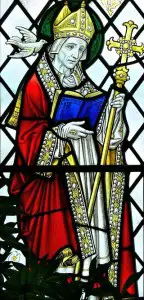 Happy St David’s Day! Yes, 1st March is the feast day of St David (Dewi Sant), the patron saint of Wales.
Happy St David’s Day! Yes, 1st March is the feast day of St David (Dewi Sant), the patron saint of Wales.
Why am I posting about that on the Anne Boleyn Files? I hear you ask.
Well, one reason is that I’m half Welsh and my Welsh roots are important to me, but the main reason is that the Tudors had Welsh roots too. Let’s not forget that Henry VII’s paternal grandfather was Sir Owen Tudor, or Owain ap Maredudd ap Tudur, whose paternal line descended from Ednyfed Fychan (d. 1246) who served as the leading servant, adviser and diplomat of Llywelyn ab Iorwerth (d. 1240), prince of north Wales, and his successor Dafydd ap Llywelyn (d. 1246).
W. Carew Hazlitt writes of how King Henry VII “having Welsh blood in his veins” felt particularly obliged to observe the feast day of St David and records show that he paid £2 one March for a feast for Welshmen. According to the Privy Purse Expenses of Henry VIII’s daughter, Princess Mary, she was presented with a leek by yeoman of the guard on the feast day in 1537, 1538 and 1544. Here’s the record of a payment made to the Yeoman of the Guard in 1544:
“Itm gevin to a yeoman of the garde for bringing a Leeke on saint Davys day – xv s.”
It is still traditional today for Welsh people to wear a daffodil or leek on 1st March, and the leek as a symbol of Wales is linked to two legends:
- The legend of the soldiers of the ancient British king, Cadwaladyr, wearing leeks so that they would know who their comrades were in battle.
- The legend that the Welsh archers fought in a field of leeks at the Battle of Crécy when Edward, Prince of Wales, defeated France. It was said that Welshmen then wore leeks on their caps on St David’s Day to remember the courage of the archers.
Steve Roud, in The English Year, points out how William Shakespeare’s Henry V (1599), has a scene “in which the English braggart Pistol makes fun of the Welsh captain Fluellen’s wearing of a leek on St David’s Day, and is forced to eat the vegetable, skin and all.” Roud also writes of how, in the 17th century, Samuel Pepys recorded in his diary for March 1667 the practise of hanging out dolls and scarecrows with leeks on their heads, and calling out after Welshmen “Taffey” or “David” to tease them.
But who was St David?
According to Rhigyfarch’s Life of Saint David, David lived in the 6th century and founded religious centres including Glastonbury and Croyland. He then travelled to the Holy Land and was made archbishop at Jerusalem before travelling back to Wales and settling at Glyn Rhosyn, or St David’s. There, he founded a monastery whose site is now marked by St David’s Cathedral.
Dewi and his community were said to have performed many miracles which included Dewi causing the ground to rise beneath him while preaching at the Synod of Llanddewibrefi so that everyone could see him.
Dewi died in 589 and was recognised as a Catholic saint in 1120.
Tim Peake has sent Wales a St David’s Day message from space – read more about this and see the video of his message at http://www.walesonline.co.uk/news/wales-news/tim-peake-sent-wales-st-10969398.
Notes and Sources
Image: Stained glass depciting St David from Our Lady and Saint Non’s chapel, St David’s, Wales, photo by Wolfgang Sauber.
- Museum of Wales
- Why do we wear daffodils and leeks?
- Hazlitt, W.C. (1995) Dictionary of Faiths and Folklore: Beliefs, Superstitions and Popular Customs
- Roud, Steve (2008) The English Year
- Privy purse expenses of the Princess Mary, daughter of King Henry the Eighth, afterwards Queen Mary, ed. Frederick Madden
- Carr, A. D.. “Tudor family, forebears of (per. c.1215–1404).” A. D. Carr In Oxford Dictionary of National Biography, online ed., edited by Lawrence Goldman. Oxford: OUP, 2004.
- Griffiths, R. A.. “Tudor, Owen (c.1400–1461).” R. A. Griffiths In Oxford Dictionary of National Biography, edited by H. C. G. Matthew and Brian Harrison. Oxford: OUP, 2004.